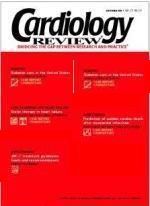Publication
Article
Cardiology Review® Online
Sildenafil offers promise in primary pulmonary hypertension
Oral sildenafil given three times daily improved exercise tolerance, cardiac index, and quality of life in patients with primary pulmonary hypertension, according to results of a controlled pilot study, the results of which were published in the Journal of the American College of Cardiology (2004;43[7]:1149-1153).
The study adds to the positive findings from previous uncontrolled studies of sildenafil in patients with primary pulmonary hypertension, according to the study’s authors. In animal models, sildenafil has been shown to be a potent pulmonary vasodilator, they noted.
In the current study, 22 patients with primary pulmonary hypertension underwent Doppler echocar-
diography and treadmill exercise testing, after which they were randomly assigned to placebo or sil-denafil. The dosage of sildenafil ranged from 25 to 100 mg three times daily based on body weight. After 6 weeks, patients were crossed over to the alternate group. Patients were included if they were in New York Heart Association functional class II or III and had an estimated pulmonary artery mean pressure greater than 30 mm Hg.
Sildenafil was well tolerated; no patient discontinued the drug because of adverse events. Exercise time increased from 475 to 687 seconds (P < .0001) and cardiac index improved from 2.80 to 3.45 L/m2
(P < .0001) after 6 weeks of sildenafil therapy. Pulmonary artery systolic pressure decreased from 105 to 98 mm Hg at the end of the sildenafil phase of treatment, but this improvement was not significant. The dyspnea and fatigue components of quality of life scores improved while patients were on sildenafil.
Current treatments for primary pulmonary hypertension are limited. Continuous intravenous infusion of prostacyclin is considered the gold standard, but the therapy “is expensive and tedious to administer, and may be associated with serious complications, such as sepsis,” the authors noted. A previous observational study by the same group of authors showed a survival advantage with sildenafil over 2 years compared with historical controls, with good tolerance and no major side effects.
Sildenafil holds promise as a first-line treatment for primary pulmonary hypertension, the authors said. Further studies are needed to assess long-term safety and efficacy of sildenafil and the potential additive benefit with other drugs.
“This study provides a lot of encouragement,” commented Robin Barst, MD, director of the Pulmonary Hypertension Center at New York Presbyterian Hospital and professor of pediatrics at Columbia University, New York City. “There’s a tremendous amount of uncontrolled data supporting the safety, efficacy, and proof of concept with sildenafil, and this is strong additional support for using it.”
One advantage of sildenafil is that, unlike an endothelin receptor antagonist used to treat primary pulmonary hypertension, no monitoring of liver function is required. Pending the results of a large, double-blind, controlled study of sil-denafil for the treatment of primary pulmonary hypertension, to be released later this year, sildenafil may prove to be an effective first-line or second-line option for patients with this disease, said Dr. Barst.
“Physicians will probably vacillate over the next few years on which drug to start with; they usually go with their most recent ex-perience,” she noted. Eventually, longer-acting phosphodiesterase inhibitors may prove even more useful than shorter-acting ones, such as sildenafil, she added.
